
Interest rates set to rise? The latest inflation results surprised with an increase in inflation. The RBA appears to be running out of excuses for reasons not to lift rates to calm inflation.
Cash Rates, Inflation, Wages Growth and Asset Pricing
- On 18 June 2024, the RBA left the cash target rate unchanged at 4.35%, with its exchange settlement balances also unchanged at 4.25%. During April, the CPI indicator rose by 3.6 per cent in headline terms and by 4.1 per cent, excluding volatile items and holiday travel. All outside of the 2 to 3 per cent target range desired by the RBA.
- In deciding to maintain rates unchanged this month, the RBA commented, “Returning inflation to target within a reasonable timeframe remains the Board’s highest priority. This is consistent with the RBA’s mandate for price stability and full employment. The Board needs to be confident that inflation is moving sustainably towards the target range. To date, medium-term inflation expectations have been consistent with the inflation target, and it is important that this remains the case.”
- The most recent RBA Chart released on 19 June 2024 shows a number of interesting developments. Australia’s GDP growth continues to decline. Aside from imports and exports, the largest single driver of GDP growth has been Government spending for the last 12 months ending 31 March 2024. Consumer sentiment continues to be at the lowest level for the past 15 years. Private dwelling investment fell below 2014 levels, while the savings rate declined to near zero.
Exhibit 1: GDP, Inflation and RBA Cash Rate

Exhibit 2: Wage Growth and Unemployment
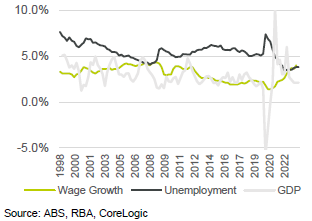
Exhibit 3: Annual House Price Movements
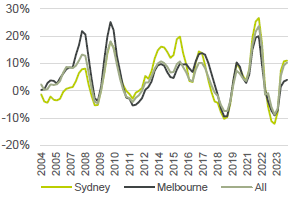
Funding Costs
- Following the latest inflation results, lenders took the opportunity to lift future rates. This contradicts the forecast consensus, which still appears to be promoting a rise in rates over the next year, followed by a cut in the 2-to-5-year period.
Exhibit 4: Reserve Bank of Australia Assets
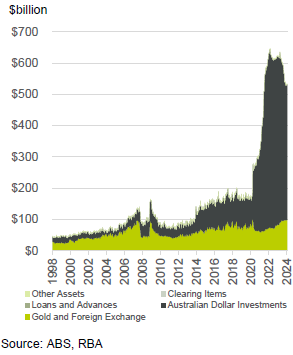
Exhibit 5: Australian Government Bond Yield
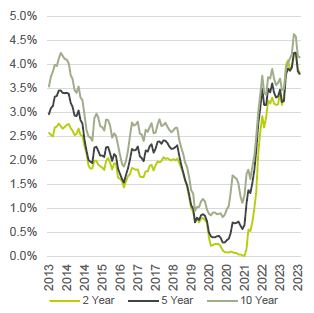
Exhibit 6: Household Income and Consumption
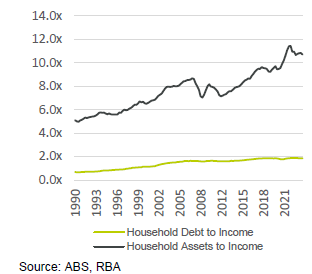
Exhibit 7: Housing Loan Commitments
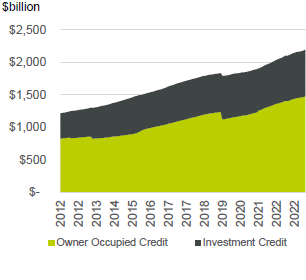
Implications on Interest Rate Outlook
- Consensus forecasts expect a potential short-term rise followed by a gradual reduction in interest rates. While we do expect the possibility of a single rate rise, we do not expect interest rates will materially lower anywhere near the ultra-low rates we had leading into the COVID-19 period.
Exhibit 16: Impact of Interest Rate Forecasts and Fixed Rates on $1 million borrowing
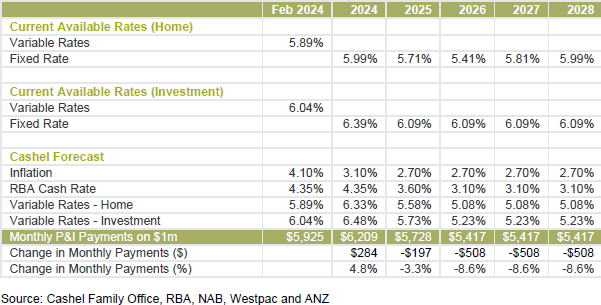
Recommended Strategies
- Consider splitting rates between variable and 3 years fixed – hedge your bets. Given the current and forecast variable rates, the 3-year fixed rates for investment and home loans look attractive compared to the variable and longer-term rates. For many Borrowers, it will be lower than their current variable rates and provide a hedge against any unexpected interest rate rises. At the same time, maintaining some variable exposure will provide some upside should the rates decline (as many hope) and you wish to accelerate repayments (particularly for non-tax effective home loans).
- Be vigilant about your interest rates. If you are not already paying the lowest variable, you should look to do so. We can aid you with renegotiating with your current lender or refinancing with a new lender. There is typically a saving of 0.5% to 1.5% based on refinancing.
- Position for opportunities. While there appears to be ongoing bad news in some areas of housing and business, we know that this is often a lagged reflection of where we have been and not where we are going. As such, you should consider the effect of news on market sentiment as an opportunity to invest when prices and vendors are beaten up.
- Ensure your finance application is ready! As a self-employed applicant, if you have not prepared and lodged your 2023 tax returns, you should do so. Lenders will require these before providing finance to you in 2024.
Contact your Cashel Relationship Manager for help and advice on any these strategy recommendations.